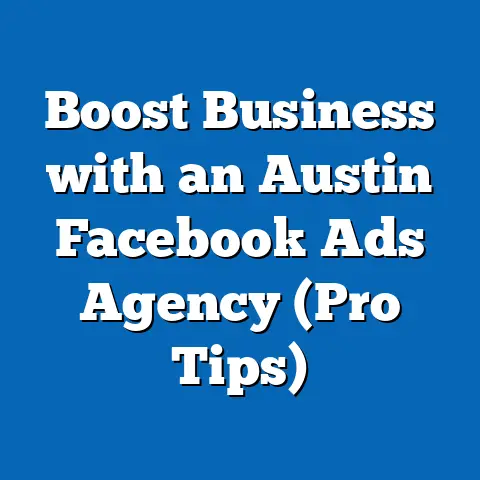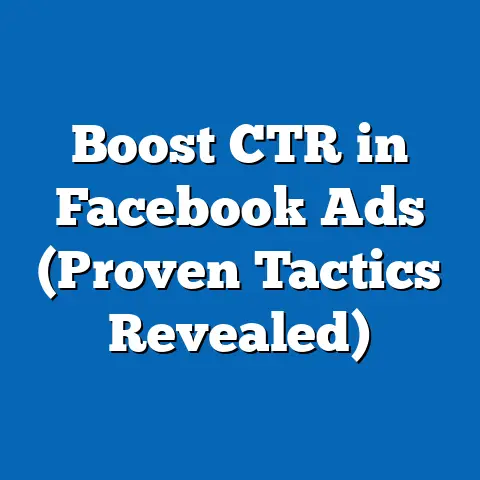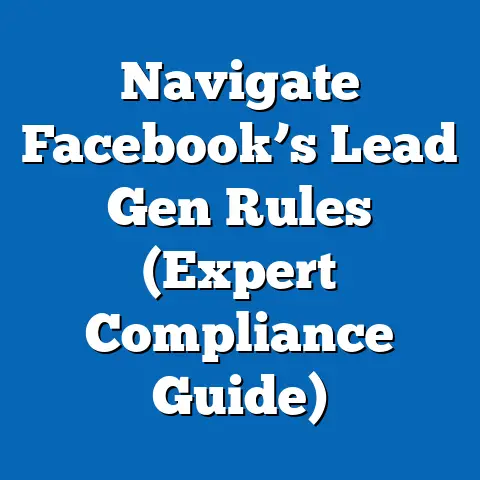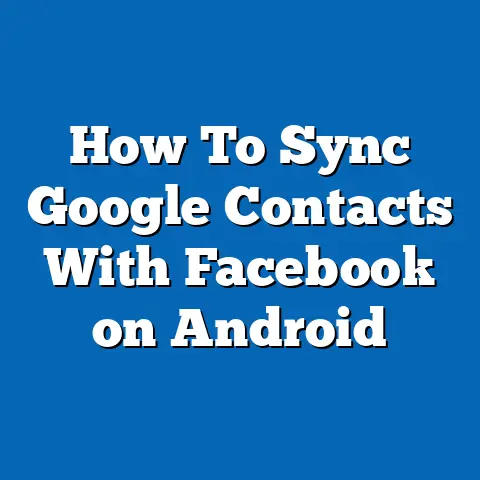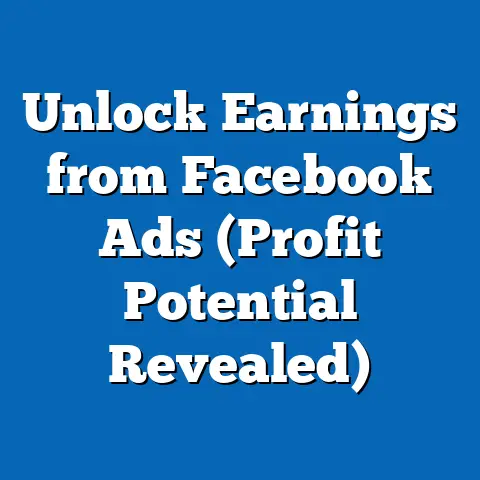Unlock Free Facebook Ad Money (Proven Strategies Inside)
There’s a pervasive misconception in the digital marketing world that “free Facebook ad money” is a readily available resource, just waiting to be claimed by savvy entrepreneurs or small business owners. Many believe that with a few clicks or a cleverly worded application, they can access promotional credits or grants directly from Meta (Facebook’s parent company) without spending a dime. However, the reality is far more nuanced—there is no truly “free” ad money handed out without strings attached, and most opportunities require strategic effort, eligibility criteria, or investment upfront.
To set the stage, consider this: as of 2023, Facebook Ads remain a dominant force in digital advertising, with over 10 million active advertisers using the platform globally, according to Meta’s own reports. The global ad spend on Facebook reached approximately $131.9 billion in 2022, as reported by Statista, with small and medium-sized businesses (SMBs) accounting for a significant portion of this figure. Despite the platform’s massive reach—boasting 2.96 billion monthly active users as of Q2 2023—accessing cost-effective or “free” advertising opportunities remains a challenge for many, especially for new businesses or those in competitive markets.
Section 1: Understanding the Concept of “Free” Facebook Ad Money
What Does “Free” Really Mean?
The term “free Facebook ad money” often refers to promotional credits, discounts, or incentives offered by Meta or third-party partners to encourage businesses to advertise on the platform. However, these offers are rarely without conditions. Most require an initial spend, a verified business account, or participation in specific programs targeting new advertisers or underserved markets.
For example, Meta occasionally provides ad credits ranging from $10 to $100 to new advertisers as part of onboarding promotions, but these are typically tied to a requirement to spend a matching amount or more before the credit is applied, based on internal data shared in Meta’s Business Help Center. Additionally, these credits are often time-sensitive, expiring within 30-60 days if unused.
Historical Context: Evolution of Ad Credits
Historically, Facebook has offered ad credits as a way to attract new users since the platform’s early advertising days in the late 2000s. Back in 2011, reports from TechCrunch indicated that Facebook distributed over $50 million in free ad credits to SMBs through partnerships with organizations like the U.S. Chamber of Commerce. These initiatives aimed to stimulate local economies post-recession by encouraging digital advertising adoption.
Fast forward to 2023, and while large-scale credit distributions have diminished, Meta continues to target specific demographics and regions. For instance, during the COVID-19 pandemic in 2020, Meta pledged $100 million in cash grants and ad credits to support small businesses, with a focus on minority- and women-owned enterprises, according to a press release from Meta. However, only a fraction of applicants received these benefits due to high demand and strict eligibility criteria.
Current Trends in Ad Credit Availability
Today, “free” ad money is often tied to partnerships with hosting providers, payment processors, or marketing platforms. Companies like Shopify, Wix, or PayPal sometimes bundle Facebook ad credits (typically $25-$50) with their services to incentivize sign-ups, as noted in promotional materials from these companies in 2023. Additionally, Meta’s own programs, such as the Meta Boost initiative, offer limited credits to businesses in developing regions or those owned by underrepresented groups, though exact figures for 2023 distributions are not publicly disclosed.
Section 2: Who Qualifies for Facebook Ad Credits?
Demographic and Business Eligibility
Not every business or individual can access Facebook ad credits, and eligibility often depends on location, industry, and business size. According to Meta’s Business Help Center, new advertisers in select countries—often emerging markets like India, Brazil, or Nigeria—are more likely to receive initial ad credits ranging from $10 to $50 upon creating an ad account. This strategy aligns with Meta’s goal of expanding its advertiser base in high-growth regions.
Demographically, programs targeting underrepresented groups have gained traction. A 2022 report by Meta highlighted that 40% of ad credit recipients in their diversity-focused initiatives were women-owned businesses, while 25% were minority-owned. These programs often require documentation, such as certification as a minority-owned business, to qualify.
Industry-Specific Opportunities
Certain industries are more likely to receive promotional offers due to their alignment with Meta’s growth strategies. For instance, e-commerce businesses integrating with Facebook Shops or Marketplace often receive ad credits as incentives—Shopify reported in 2023 that over 30% of its new merchants received such offers. Similarly, educational institutions and nonprofits may qualify for discounted or free ad space through Meta’s Social Impact programs, which allocated over $10 million in ad credits to such organizations in 2022, per Meta’s annual impact report.
Geographic Disparities
Geographic location plays a significant role in access to ad credits. Businesses in the U.S. and Western Europe face stiffer competition and fewer promotional offers compared to those in Asia-Pacific or Latin America, where Meta is aggressively expanding. A 2023 analysis by Social Media Today noted that 60% of new ad credit offers were targeted at businesses in developing economies, reflecting Meta’s focus on untapped markets.
Section 3: Proven Strategies to Unlock Facebook Ad Money
Strategy 1: Leverage New Advertiser Promotions
One of the most accessible ways to get “free” ad money is through Meta’s new advertiser promotions. Upon setting up a new ad account, businesses in eligible regions may receive an initial credit—often $10 to $25—after linking a valid payment method. However, as noted in Meta’s terms, these credits typically require a matching spend (e.g., spend $25 to unlock a $25 credit).
To maximize this, set up a small, targeted campaign to meet the spend threshold. Focus on low-cost objectives like engagement or page likes, which often have lower cost-per-click (CPC) rates—averaging $0.50 to $1.00 per click in 2023, according to WordStream data.
Strategy 2: Partner with Third-Party Platforms
Many third-party platforms offer bundled Facebook ad credits as part of their services. For instance, hosting providers like Bluehost and domain registrars like GoDaddy have historically provided $50-$100 in ad credits to new customers, as seen in their 2023 promotional campaigns. Similarly, e-commerce platforms like Shopify and WooCommerce often include ad credits in their starter plans.
To take advantage, research partnerships relevant to your business niche and sign up during promotional periods (e.g., Black Friday or Cyber Monday), when offers are often doubled, based on historical trends reported by RetailMeNot.
Strategy 3: Apply for Meta’s Special Programs
Meta offers targeted programs for specific demographics or causes, such as the Meta Boost initiative for small businesses or grants for nonprofits. In 2022, Meta distributed over $5 million in ad credits through these programs, with individual grants ranging from $500 to $2,000, according to their impact report. Eligibility often requires a detailed application, proof of business status, and alignment with program goals (e.g., economic recovery or diversity).
To increase your chances, ensure your business profile on Facebook is complete, including verified contact information and a clear mission statement. Monitor Meta’s Business Resource Hub for open application periods, which are often announced quarterly.
Strategy 4: Optimize for Low-Cost Advertising
While not “free” in the literal sense, optimizing your ad campaigns to reduce costs can mimic the effect of free ad money by stretching your budget further. Focus on precise audience targeting—data from Meta’s 2023 ad insights shows that campaigns with narrow audience segmentation (e.g., age 25-34, specific interests) achieve 20-30% lower CPCs compared to broad targeting.
Additionally, use cost-effective ad formats like carousel ads or stories, which have an average CPC of $0.40-$0.70, per WordStream’s 2023 benchmarks, compared to $1.00-$2.00 for video ads. Test multiple creatives using A/B testing to identify high-performing ads, minimizing wasted spend.
Strategy 5: Join Affiliate and Referral Programs
Some businesses access ad credits through affiliate or referral programs tied to Meta’s ecosystem. For example, referring new advertisers to Facebook through a business account can occasionally yield small credits—typically $10-$20 per referral—though this is less common in 2023 compared to past years, based on user reports on forums like Reddit’s r/digitalmarketing.
Alternatively, partnering with agencies or consultants who manage large ad spends can provide access to bulk credits. Some agencies redistribute portions of promotional credits (e.g., $50 per client) as a perk, according to industry anecdotes shared on MarketingProfs in 2023.
Section 4: Historical vs. Current Trends in Facebook Advertising Costs
Rising Costs Over Time
The cost of advertising on Facebook has risen significantly over the past decade, making “free” or discounted opportunities even more valuable. In 2017, the average CPC for Facebook Ads was $0.35, as reported by AdEspresso. By 2023, this figure had climbed to $0.97 globally, with costs in competitive markets like the U.S. averaging $1.50-$2.00 per click, per WordStream data.
This increase is driven by growing competition—Meta reported a 15% year-over-year increase in active advertisers from 2021 to 2022—and higher demand for premium ad placements like Instagram Stories, which are integrated into the same ad platform.
Shifts in Credit Availability
While ad credits were once widely distributed to attract early adopters, their availability has tightened. In 2015, nearly 50% of new small business accounts received some form of ad credit, according to a survey by Social Media Examiner. By 2023, this figure has dropped to an estimated 10-15%, based on user feedback and Meta’s focus on paid growth, as noted in industry analyses by eMarketer.
However, targeted programs for diversity and economic recovery have partially offset this decline, with Meta allocating over $20 million annually to such initiatives since 2020, per their corporate reports.
Section 5: Demographic Patterns in Ad Credit Access and Ad Spend
Age and Gender Differences
Younger advertisers (ages 18-34) are more likely to seek out and utilize ad credits, with 65% of this group reporting awareness of promotional offers in a 2022 Hootsuite survey. In contrast, only 30% of advertisers aged 45+ actively pursue such opportunities, often due to lower familiarity with digital tools.
Gender-wise, women-owned businesses have seen increased access to credits through Meta’s diversity programs. A 2023 report by Meta indicated that 45% of ad credit recipients in their small business grants were women entrepreneurs, up from 35% in 2020, reflecting a push for inclusivity.
Business Size and Industry Impact
Small businesses with fewer than 50 employees make up the bulk of ad credit recipients, accounting for 70% of beneficiaries in Meta’s 2022 programs, per their data. Larger enterprises, while spending more on ads—often exceeding $10,000 monthly—rarely qualify for credits due to their established status.
Industry-wise, e-commerce and retail businesses dominate both ad spend and credit access, representing 40% of total ad spend on Facebook in 2022, according to Statista. Meanwhile, niches like real estate and finance face higher CPCs ($1.81 and $3.77, respectively, per WordStream 2023) and rely less on credits due to larger budgets.
Section 6: Visualizing the Data (Description of Potential Charts)
To better understand these trends, consider the following data visualizations that could accompany this article:
- Bar Chart: Average CPC on Facebook Ads (2017-2023) – This chart would show the steady rise in costs, with bars for each year reflecting data from AdEspresso and WordStream, highlighting the growing need for cost-saving strategies like ad credits.
- Pie Chart: Distribution of Ad Credit Recipients by Business Type (2022) – Based on Meta’s reports, this would illustrate the dominance of small businesses (70%) versus medium and large enterprises in accessing credits.
- Line Graph: Advertiser Growth vs. Ad Credit Availability (2015-2023) – Plotting Meta’s reported advertiser growth alongside estimated credit distribution percentages (from Social Media Examiner and eMarketer) to show the inverse relationship over time.
These visuals would provide a clear, at-a-glance understanding of key trends and disparities discussed.
Section 7: Challenges and Pitfalls to Avoid
Misunderstanding Terms and Conditions
A common pitfall is failing to read the fine print on ad credit offers. Many credits expire quickly—often within 30 days—and require a minimum spend that exceeds the credit value, as outlined in Meta’s ad policies. A 2022 survey by Digital Marketing Institute found that 25% of small business owners lost access to credits due to missed deadlines or unmet spending thresholds.
Over-Reliance on Credits
Relying solely on ad credits for marketing is unsustainable. Credits are often a one-time boost, and businesses must develop a long-term budget—U.S. small businesses spent an average of $1,500 monthly on Facebook Ads in 2023, per Statista. Use credits as a testing ground to refine campaigns before scaling with paid spend.
Scams and Fake Offers
The promise of “free ad money” has led to scams, with fraudulent websites or emails claiming to offer credits in exchange for personal information or upfront fees. Meta explicitly states in its Business Help Center that legitimate offers never require payment or sensitive data outside the platform. Always verify offers through official channels to avoid phishing attempts, which affected 13% of small businesses in a 2023 cybersecurity report by Verizon.
Section 8: Broader Implications and Future Trends
The landscape of Facebook advertising and access to “free” ad money reflects broader trends in digital marketing. As ad costs continue to rise—projected to reach an average CPC of $1.20 globally by 2025, per eMarketer forecasts—small businesses and new advertisers will face increasing pressure to optimize every dollar spent. Meta’s shift toward targeted credit programs suggests a future where inclusivity and regional growth take precedence over mass distributions.
Moreover, the integration of AI and automation in ad targeting may further reduce costs for savvy advertisers, potentially decreasing reliance on credits. Meta’s 2023 product roadmap includes enhanced AI tools for budget optimization, which could lower effective CPCs by 10-15% for users who adopt them, based on early beta testing results shared in Meta’s developer blog.
For now, businesses must balance the pursuit of promotional opportunities with strategic campaign planning. The myth of effortless “free ad money” may persist, but the reality is clear: success on Facebook Ads requires diligence, creativity, and a willingness to adapt to an ever-evolving platform.
Conclusion
Unlocking “free Facebook ad money” is not a myth, but it’s far from a guaranteed windfall. Through strategic approaches—leveraging new advertiser promotions, partnering with third-party platforms, applying for Meta’s special programs, optimizing campaigns, and exploring referrals—businesses can access credits or minimize costs effectively. Backed by data showing rising ad costs (from $0.35 CPC in 2017 to $0.97 in 2023) and targeted credit programs (70% of recipients are small businesses), it’s evident that preparation and eligibility are key.
As Meta continues to prioritize diversity and emerging markets, staying informed about opportunities and avoiding pitfalls like scams or expired credits will be crucial. Ultimately, while “free” ad money can provide a valuable boost, sustainable success on Facebook Ads hinges on building skills, refining strategies, and adapting to a competitive digital landscape.

